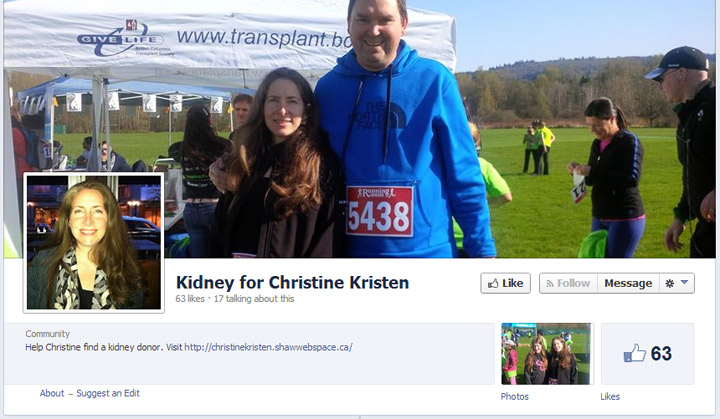Like most web-savvy Canadians, she has a website and a Facebook page promoting her cause. But Christine Kristen’s social media footprint is all about saving her life.

The 43-year-old mother of two has kidney disease and the wait list for a deceased donor is up to eight years. She’s taking her fate into her own hands to appeal to the rest of the world online.
Kristen is part of a growing trend of patients waiting for organs who are turning to social media in a novel way of finding a donor.
“Nowadays it’s complete strangers who put their hands up to help other people. It completely blows my mind that some people are so unselfish and willing to do that,” she said.
READ MORE: Little girl’s organs her ‘final gift to the world’ following car crash
Peggy Lane, a spokeswoman for B.C. Transplant, has seen it happen a handful of times.
“It’s not really overtly prevalent but it is starting to prove to be another way in which people can reach out,” Lane said.
“While it may not be someone in your immediate circle [who donates], it spreads like a ripple effect. It may be someone in your friend’s circle who may be impacted by your story and decides to come forward.”
B.C. Transplant is the provincial agency that oversees and funds transplant donation in three different transplant centres.
In the organization’s brochure doled out to those waiting for a transplant, officials even advise them to consider using the web to reach a larger audience.
“The reality is donating a kidney is not insignificant…it’s hard face-to-face to say, but you can tell your story that can reach a lot of people more so than the traditional methods,” Lane said.
Right now, the national living donor average is about 17 donors per one million people. British Columbia has the highest rates at 28 living donors per million.
READ MORE: Organ donation shortfalls in Ontario hospitals without transplant programs
Kristen, who is adopted, first learned she had the kidney disease in 1992 when her birth mother contacted her. But the illness only presented itself in 2011.
- Train goes up in flames while rolling through London, Ont. Here’s what we know
- Budget 2024 failed to spark ‘political reboot’ for Liberals, polling suggests
- Wrong remains sent to ‘exhausted’ Canadian family after death on Cuba vacation
- Peel police chief met Sri Lankan officer a court says ‘participated’ in torture
The mom often took to hiking, biking and martial arts, but she grew lethargic and she had trouble breathing.
Her dress size also kept creeping up. Multiple cysts were growing on her kidneys — her organs are now the size of footballs because of the cysts. Soon, she may go into renal failure.
READ MORE: Berlin Heart technology helps kids waiting for heart transplants
“If you’ve ever been pregnant, it’s sort of like being pregnant a lot,” according to Dr. Jean Shapiro, a UBC professor and Kristen’s kidney specialist.
“Some people get into trouble more quickly with kidney failure than others, regardless of the size of cysts or whether the kidneys are very big. It’s variable,” Shapiro explained. Other organs, such as the liver and stomach, are affected as Kristen’s cysts grow.
Shapiro said that Kristen can’t go on dialysis until she hits about eight per cent kidney function. At that point, she could be on an eight-year wait list for a deceased donor.
READ MORE: Kidney transplants could save health care system millions, report says
About five per cent of all people requiring dialysis or kidney transplantation have polycystic kidney disease, according to Canada’s Kidney Foundation.
See Kristen’s website and Facebook page.
carmen.chai@globalnews.ca
Follow @Carmen_Chai





Comments